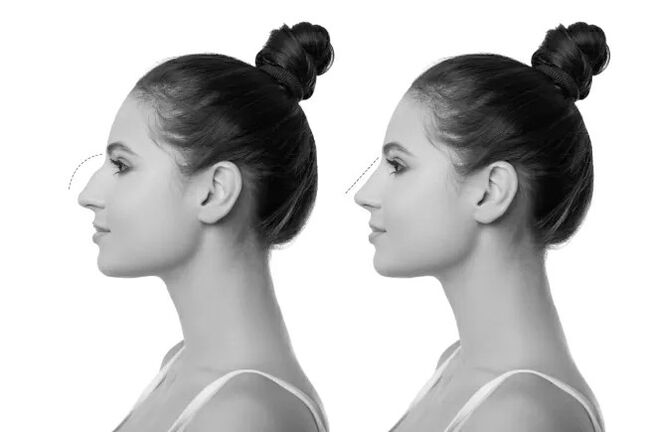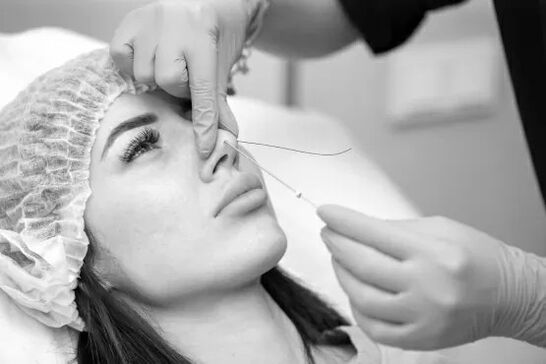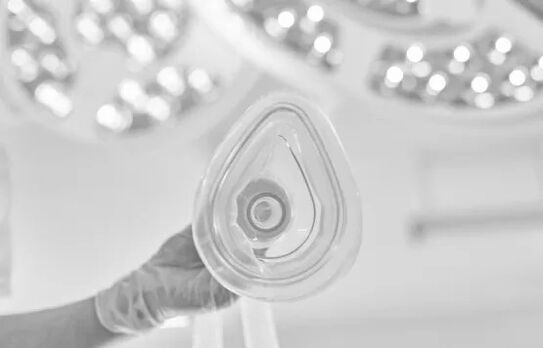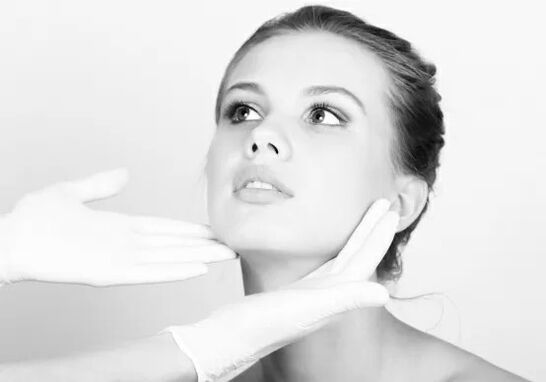Every third person on the planet thinks of a nose correction at least once. 70% of patients choose rhinoplasty because they are 100% dissatisfied with its appearance and want to solve an aesthetic problem: get rid of bumps, make the nose thinner, smaller, smoother. 30% of patients decide on rhinoplasty for medical reasons - nasal injury, difficulty breathing, deviated nasal septum or frequent sinusitis.
Problems with the shape of the tip of the nose are not uncommon. But don’t be shy, everything can be fixed. If the lack of figure can be corrected with clothing, diet or sports, then you need to contact a plastic surgeon to correct your nose or lips.
We will discuss all the features of the procedure, preparation for plastic surgery and other important stages in this article.
Indications and contraindications: medical, aesthetic, indirect, absolute

Rhinoplasty is a surgical procedure that takes 1-2 hours. As a result, the patient's appearance changes and the face becomes more attractive. Before carrying plastic, it is necessary to agree all things with the doctor and fully prepare for its implementation: pass the test, follow a diet, stop smoking and alcohol at least a week before surgery.
Indications for surgery
Indications for the procedure are congenital and acquired.
Congenital indications for plastic surgery are a variety of aesthetic and physiological defects: hook -shaped tip, fork, thick or drooping, its displacement to the side, nostrils that are too wide or narrow.
Surgery may be required after an injury or illness in which nasal curvature occurs, as well as in case of difficulty breathing due to organ structure or age -related changes (skin aging). The above instructions are considered obtained.
To restore or correct the tip of the nose, you should consult a surgeon, if surgery is needed, cartilage density, skin and tissue thickness, length, width of the nose, and other factors will be taken into account. The wishes of the patient are always taken into account, and even realized as much as possible, but the final decision is made together with the doctor, because the removal of excess cartilage can lead to poor health.
Before surgery, you need to check the cartilage of the nose, and also make sure that the skin in the area of the respiratory organs is healthy - there is no inflammation or signs of infection.
Contraindications to surgery
Correction of the tip of the nose is a serious procedure, it must be done consciously. What are the contraindications to the procedure?
- Age.The operation was performed from the age of 18 years. By this age, tissue formation occurs completely. However, surgeons recommend correcting the tip of the nose between the ages of 20 and 35 years. It is then that bone and cartilage formation is complete, the skin is elastic, and regrowth after the active procedure.
- Blood clotting problems.When a patient experiences poor blood clotting, the risk of surgery is higher than usual and it is therefore better to reject it.
- Exacerbation of chronic diseases.Surgeons do not recommend performing surgery during a worsening disease. It is better to wait until the health condition is normalized and undergo an examination. Only if a positive test result can one decide on rhinoplasty.
- Viral diseases, infections, inflammation.It should be noted that if there is a health problem at least, it is better to postpone the operation until full recovery.
- Oncology.Rhinoplasty is contraindicated in patients with oncology.
- Menstruation.Surgery is contraindicated during menstruation. Correction should be done within two weeks after the end of menstruation.
It is also contraindicated to perform plastic surgery during pregnancy or breastfeeding. Prior to surgery, patients must be examined and tested to prepare the necessary preparations for rhinoplasty.
Other methods of correction. Why rhinoplasty is the safest method

To correct the nose, surgeons use different surgical techniques depending on the client’s wishes and the expected results the patient will receive. However, you can find other methods to fix the tip of the nose in the net.
Clamps
In the online store you can find so-called "clamps for the correction of the nose. " The manufacturer ensures that when wearing a mask 2-3 times a day, the effect will be visible, comparable to performing a surgical intervention. But, naturally, this is far from the truth. For nose correction, no clips or other tools from a pseudo specialist work. If there is an effect, it will be short -term - for 2-3 weeks, and the correction is not significant.
Exercise
There is a set of exercises for the face that allow you to correct its shape. This exercise is useful for maintaining muscle tone, cheekbones and twin chin, but this exercise will not work to improve the shape of the cartilage. The effect after systemic training continued for 2 weeks.
Correction with thread
The threading technique is performed by a specialist with a special needle through a micro puncture. A specially designed grooved thread is inserted into the skin of the nose, which forms the frame. The thread is inserted through a small puncture, and the frame keeps it fixed in position. After two days, the doctor removes the end of the thread and the patient sees the final result, which lasts for about 3 years.
Use of hormone medications
To correct the tip of the nose, you can also take hormone medications. First of all, you need to consult an endocrinologist. If there are no contraindications, hormone medications can be given. This procedure is performed to remove excess soft tissue and lift the ends. For correction, you will need to undergo a procedure that will last from 2 to 3 weeks. Keep in mind that such drugs have a temporary effect - from 3 months to 2 years, depending on the chosen drug.
Surgical correction
According to experts, rhinoplasty is the most reliable and effective method of correction. Unlike previous methods, rhinoplasty provides lifelong results. The procedure lasts 1-2 hours under local or general anesthesia. The main advantages of the operation:
- all possible correction options (lower or raise the tip, reduce, straighten or narrow the tip of the nose);
- elimination of respiratory problems;
- lifelong outcomes;
- injury correction, birth defects.
3 Techniques for performing operations. What is the difference
There are several types of rhinoplasty: closed, open and classical hybrid methods. Surgeons use different types of plastic surgery depending on the outcome to be achieved, the shape of the nose, the position of the bone and cartilage tissue, and other factors.
The feature of classic closed plastic surgery is that it can be used to correct the nasal dorsum, but correction of the tip is more difficult than using an open one. In this method, an incision is made in the nasal passage and access to the tip is only possible when the cartilage is removed into the incision. But there is also an advantage - no visible scars after surgery. Closed plastic is ideal for removing bumps or correcting bone tissue in the event of its curvature.
If the surgery is open, the surgeon makes additional incisions between the nostrils. This contributes to better access to the structure of the nose, most likely to change its size and shape. The scars after the procedure will be almost invisible and small. With this method, you can reshape the tip of the nose more effectively (compared to the closed method). The disadvantage is the possibility of the formation of small scars on the outside of the nose and a longer recovery period. The scar becomes smaller after a few months after surgery, and it can also be removed with the use of healing agents and additional creams, which will be recommended by the surgeon, if necessary.
Because the above method has its drawbacks, surgeons have developed a plastic fusion technique. While using it, an incision is made in the nose, which is a feature of the second method, but, unlike the open method, there is no external incision on the skin.
Combined methods (also known as "hybrids") have been developed taking into account all the advantages and disadvantages of closed and open methods.
The main advantage is the ability to change the structure of the nose as much as possible and not leave visible scars. Recovery after the combination method occurred within 2 weeks, and no scars were visible on the skin.
While using the hybrid method, the surgeon has the opportunity to make corrections during the operation, as well as handle the desired result, avoiding the possibility of excessive or insufficient corrections. The combined method has only one drawback - it is more complicated from a technical point of view.
A few words about something important. Prepare for surgery

Before doing rhinoplasty, you need to undergo training. You will need to see a plastic surgeon to discuss the desired changes. The surgeon examines the nose and explains the reality of getting the desired result. During the negotiations, questions about the limitations, operation, uniqueness of its preparation, subsequent recovery, as well as possible complications were discussed.
Prior to surgery, patients should be examined to ensure that there are no contraindications, and pass the following tests:
- blood for HIV infection and hepatitis C and B;
- clinical blood tests;
- blood biochemistry;
- laboratory analysis of urine;
- prothrombin index analysis;
- fluorography;
- electrocardiography;
- tests for tumor markers;
- roentgenogram.
Also, patients need to listen to the doctor’s recommendations and adhere to them. Avoid drinking alcohol a week before surgery, stop smoking, do not use blood thinners, do not drink water or eat food for five hours before the procedure. It is important to refrain from active activities and walk in the scorching sun a few days before rhinoplasty.
In the course of operations and its main stages

Rhinoplasty is performed under general or local anesthesia. The choice of the type of anesthesia depends on the client’s wishes and the uniqueness of the operation, and on the method that the plastic surgeon will use while performing it. The patient is always able to convey his or her wishes regarding anesthesia, but the final decision is made by the doctor. The process and quality of recovery after rhinoplasty also depends on the choice of type of anesthesia.
Local anesthesia is used in the event of a minor correction to the nose with an injection of hormones, fillers or threads. This method of correction does not cause severe pain, therefore general anesthesia is not required in most cases. But this type of anesthesia is practically not used in rhinoplasty, when the surgeon has to touch the nasal bone or cartilage.
General anesthesia is used by surgeons in most cases. This type of anesthesia allows you to avoid pain completely during the operation and the patient will have no memories of the operation.
The operation takes 1-2 hours. After anesthesia, the surgeon makes an incision in the skin or mucous membranes. Depending on the patient’s wishes and the particular case, the doctor chooses an open or closed method for surgery.
During rhinoplasty, the doctor separates the soft tissue of the nose from the bone and cartilage in the nasal cavity. Then he performed a fractional movement of cartilage and bone, modeling a new shape of the nose. After manipulation, the plastic surgeon uses sutures that can be absorbed into the skin or mucous membranes, depending on where the incision is made. The next step is to patch the nasal passages with a large gauze tampon. The final stage of operation is the imposition of adhesive mounts.
The type of incision chosen by the surgeon depends on the structure of the nose, the complexity of the procedure and the choice of the surgeon in the job. Cuts can be axial, perpendicular, oval or angular.
Rhinoplasty itself is performed with three main methods: open, closed and combined. The characteristics of each method are described in the sentence "type of operation"
The choice of plastic surgery method is communicated to the patient directly, but doctors recommend choosing the method with the lowest level of trauma. Surgeons say that the least traumatic method is closed and combined, because in the case of its use, small incisions, and recovery after surgery is faster.
Surgeon's recommendation in the postoperative period. How to avoid complications

Recovery after surgery is on average 20 to 25 days. If rhinoplasty is performed with general anesthesia, the patient must also be hospitalized for 24 hours after surgery.
For three days after surgery, a gauze or cotton swab should be in the nasal cavity to ensure new movement and prevent swelling. On days 5-8 (depending on the speed of healing) after the plasty, the suture material is removed. After a week or 10 days, the patient is removed from the cast plaster, the hematoma and swelling begin to disappear gradually.
Doctor's recommendation in the postoperative period:
- Sleep on your back, be sure to use high pillows.
- To reduce the level of discomfort associated with dry mouth (as one of the possible consequences of the procedure), use a special solution or paste to soften.
- Do not abuse alcohol and smoke.
- Refuse travel to baths, solariums, saunas.
- Do not wear glasses.
- Do not burden yourself with physical activity.
- Pause for hot food and drinks.
- Do not touch, knead, or feel your nose.
Possible complications
Complications after rhinoplasty are rare. Some of them appear immediately after correction, while others appear at a later stage of healing. Natural complications include edema and bruising. Signs of external swelling disappeared within a week after plastic surgery, internal swelling disappeared after six months. The difficulty in breathing disappeared on its own 10 days after surgery.
To protect yourself as much as possible from possible complications, it is important to choose a specialist, clinic and provide complete information about your health status, injury or illness, if any. The end result of the operation performed also depends on strict adherence to the recommendations of the doctor during the recovery period.
In conclusion
Rhinoplasty is used by women and men of any age. Surgeons advise to perform surgery to repair the tip of the nose at a young age and not to delay it. It is important to undergo a full examination, to ensure that there are no contraindications to plastic surgery. The most popular indications for rhinoplasty are:
- correction of the tip of the nose (large, sharp or round);
- long nose;
- wide nose bridge;
- lifting the tip of the nose or narrowing it;
- elimination of asymmetry;
- difficulty breathing;
- removal due to injury or low -quality rhinoplasty;
- correction of the tip of the broken nose.
If the patient has a minor defect, the operation is performed under local anesthesia. In 90% of other cases, rhinoplasty is performed under general anesthesia. The procedure itself lasts from one to two hours. The method of performing the procedure (open or closed) is based on many factors. This includes the complexity of the nasal defect and the wishes of the client. But the final decision remains with the plastic surgeon.
The quality of rhinoplasty and the end result directly depends on the choice of specialist and clinic, so this must be approached holistically.




















